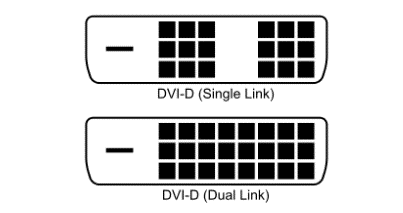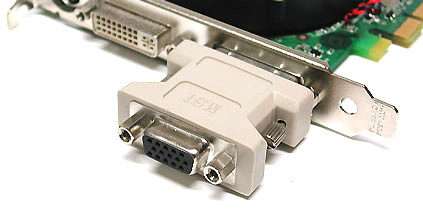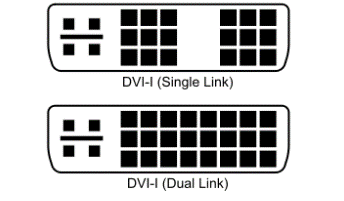May 05, 2023
3150
DVI's full English name is Digital Visual Interface, known as "Digital Video Interface" in Chinese. It is a high-speed transmission of digital signals technology that is designed to transmit uncompressed digital video. It is widely used in LCD, digital projectors and other display devices.
The DVI interface is built upon Silicon Image's PanelLink interface technology and employs the TMDS (Transition Minimized Differential Signaling) electronic protocol for its fundamental electrical connection. By utilizing a differential signaling mechanism, TMDS enables the encoding and transmission of pixel data through a serial connection. The graphics card generates a digital signal that is encoded by the transmitter according to the TMDS protocol, and the resulting signal is then sent through the TMDS channel to the receiver, where it is decoded and ultimately delivered to the digital display device.
A DVI display system consists of a transmitter and a receiver. The transmitter is the source of the signal, either built into the graphics card chip or in the form of an add-on chip on the graphics card PCB; and the receiver is a piece of circuitry on the display that accepts the digital signal, decodes it and passes it to the digital display circuitry, through which the signal from the graphics card becomes the image on the display.
DVI connectors can also contain the legacy analog (VGA) signal footprint in addition to the digital signal footprint as defined by the DVI standard. This is designed to maintain the versatility of DVI so that different display formats can share the same connection cable. DVI interface has 3 types of 5 specifications.
DVI-D (Digital signal; single link or dual link)
DVI-D ( DVI-Digital ) is a pure digital signal interface and can only be used to connect signals from the DVI-D interface, not compatible with analog signals; DVI-D has 18 or 24 digital jacks + 1 flat jack.

DVI-A (Analog analog signal)
The DVI-A (DVI-Analog) interface utilizes an analog signal and can only be connected to DVI-A or VGA interface signals. In essence, it adheres to the VGA analog transmission interface specifications and is typically employed to transfer the DVI-I output of graphics cards to the D-Sub monitor interface.

DVI-I (Integrated hybrid; both digital and analog signals are possible; single link or dual link)
DVI-I (DVI-Integrated) interface, which is compatible with both DVI-I and DVI-D plugs, is compatible with both digital and analog signals, and has 18 or 24 digital jacks + 5 jacks for analog signals. At present, graphics cards generally use DVI-I interface, its conversion connector, you can connect to the ordinary VGA interface. Usually, the monitor with two DVI interfaces, or DVI, VGA interface each one.
It can be understood as follows → When DVI-I is connected to VGA, it plays the role of DVI-A; when DVI-I is connected to DVI-D, it only plays the role of DVI-D.

Only support analog signal interface: DVI-A (12 + 5).
Support only digital signal interface: DVI-D, which is further divided into single connection DVI-D (18+1) and dual connection DVI-D (24+1).
Simultaneous support for analog and digital signal interfaces: DVI-I, which is further divided into single-connector DVI-I (18+5) and dual-connector DVI-I (24+5).
Compared to single-channel DVI, dual-channel DVI is configured with more conductors for signal transmission. Single-channel DVI supports a maximum bandwidth of 165 MHz (1920 x 1080@ 60 Hz, 1280 x 1024@ 85 Hz) and only 18 contacts in the connector can be used for transmission. Dual-channel DVI connectors have 24 contacts that can be used to transmit signals and support a maximum bandwidth of 2x165 (2048 x 1536@60 Hz, 1920 x 1080@85 Hz).
DVI-D only supports digital signals, while DVI-I not only supports digital signals, but also analog signals, which means DVI-I is more compatible.
The transmission rate of single connection DVI interface is only half of the dual connection, 165MHz/s, and the maximum resolution and refresh rate can only support up to 1920x1200,60hz. As for the dual-connected DVI interface, it supports up to 2560x1600, 60Hz mode, and can also support 1920x1080, 120Hz mode. DVI-I supports digital/analog conversion interface types, so if the monitor has only one DVI interface, it will be paired with DVI-I that supports both digital/analog modes. If the monitor has both DVI and VGA connectors, it will be paired with DVI-D.
DVI transmission is a digital signal, digital image information in the transmission process without any conversion, will be transmitted directly to the monitor, so it will reduce the digital-analog-digital cumbersome conversion process, greatly saving time, so it is faster, effectively eliminating the phenomenon of trailing, lagging, and the use of DVI for data transmission, the signal is not attenuated, the color is more pure, more realistic.
Digital signal, to avoid the analog / digital conversion process, the signal is not attenuated, the color is more pure and lifelike.
For example, in the use of VGA interface connection monitor need to first signal through the graphics card in the D / A (digital / analog) converter into R, G, B three primary color signal and line, field synchronization signal, but also need the corresponding A/D (analog / digital) converter will once again turn the analog signal into a digital signal in order to display the image on the monitor to. This is the digital-analog-digital process.
In the above VGA interface in the D / A, A/D conversion and signal transmission process will inevitably be the loss of signal and interference, resulting in distortion of the image or even display errors, while the DVI interface does not need to carry out these conversions, to avoid the loss of signal, is the clarity of the image and detail performance has been greatly improved.
DVI interface is a high-definition interface, but without audio, that is, DVI video wiring only transmits the picture graphics signal, but not the audio signal. DVI interface disadvantages: As the initial design is carried out for the PC side, so for TV and other poor compatibility, only support 8bit RGB signal transmission, compatibility considerations, set aside a number of pins to support analog devices, resulting in a larger interface volume. The current better DVI interface can transmit 2K screen, but it is also basically the limit.
Transfer of Uncompressed Digital Video
DVI interfaces support various video resolutions and refresh rates, making them suitable for a wide range of applications, including gaming, video editing, and graphic design. However, newer interfaces such as HDMI and DisplayPort have largely replaced DVI in newer devices, as they offer higher bandwidths, more features, and support for audio transmission.